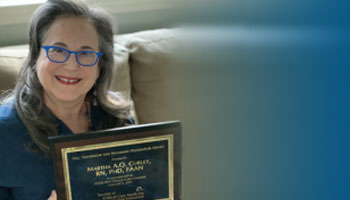HOW CAN WE HELP YOU? Call 1-800-TRY-CHOP
In This Section
“Creating a Healing Environment:” Martha Curley, RN, Receives Critical Care Award

Martha Curley, RN, PhD, FAAN, received the Drs. Vidyasagar and Nagamani Dharmapuri Award from the Society of Critical Care Medicine.
Nurses provide enormously important care to critically ill children and their families in the intensive care unit. Watchful and well informed, caring and constant, they are undoubtedly in the best position to identify and pursue ways to intervene when patients and their families need them to do so.
This year, the Society of Critical Care Medicine (SCCM) awarded the Drs. Vidyasagar and Nagamani Dharmapuri Award for Excellence in Pediatric Critical Care Medicine to our own Martha Curley, RN, PhD, FAAN. Dr. Curley is the first nurse to receive this award, which recognizes an individual for their “sustained exemplary and pioneering achievement” in the care of critically ill and injured infants and children.
As the Ruth M. Colket Endowed Chair in Nursing at CHOP, Dr. Curley’s extensive research has transformed how care is fundamentally provided to critically ill children, from the development of novel assessment instruments, to the creation of interventions to partner with parents, and much more. In this Q&A, we sat down with Dr. Curley to learn more about her research, career, and perspective on the importance of nursing science in pediatric critical care.
What does receiving this award mean to you?
I am excited to receive the award because it acknowledges a lifetime of work that has cleared the path to recognize the contributions that nurses make in the care of critically ill children and their families. It’s also important from the perspective of situating the patient and the parent in this award, because all of the work that I’ve done over the years has been based on the needs of patients and their families. So, it’s great to have this work acknowledged. I’m humbled by the award and honored to receive it, especially as the first woman and nurse to receive it.
Can you share how long you have been a nurse scientist, and what drew you to this career?
I spent years as a clinical nurse specialist in the multidisciplinary intensive care unit at Boston Children’s Hospital. In that role, I was the nurses’ nurse, helping them provide the best care possible for our patients. As a clinical nurse specialist, you’re always looking for the best evidence to apply to patient care. There’s a lot of data in adult or neonatal intensive care, but not necessarily in pediatric intensive care. So, as a clinical care specialist, my questions were always about the data to support the different interventions we provided at the bedside. Given that there wasn’t a lot of data, I became very interested in generating it. That’s why as a clinical nurse specialist, I went back to do a PhD in nursing science, so that I could ask and answer the questions nurses derived from clinical practice.
Could you tell us about some of your past and current research work?
The studies that I’ve done have been in three areas. The first area has been about developing valid and reliable instruments to better assess patients. I developed instruments that help nurses assess pain in non-verbal children, instruments to assess sedation in intubated children, and instruments that assesses patients’ risk for pressure related injuries when they’re critically ill.
Another area articulates how best to partner with the parents of critically ill children. I designed an intervention that helped parents take care of their critically ill child and a care model that helps parents and nurses partner in a better way to collectively help their children, especially during invasive procedures or resuscitation.
Finally, my bigger studies have been centered around helping the care of pediatric patients with acute respiratory distress syndrome. The current study is called the PROSpect study, a large multicenter clinical trial that we’re running internationally to test two interventions commonly used in critically ill children with acute respiratory failure. One is prone positioning, and the other is high-frequency oscillatory ventilation. We’re also testing this in a novel design, an adaptive randomized trial, wherein we may enroll up to 1,000 patients, but after 400, we start looking at data and preferentially place patients in the better-performing arms of the study.
What are some research questions you’re pursuing, or would like to pursue, in your work?
Most of the questions that I have are about giving nurses the data they need to practice more autonomously. How do we give nurses data to assess, intervene, and really increase their capacity to partner with other professionals at the bedside?
It’s fun asking questions, answering them, and then moving on to the next question. For example, my risk-prediction measure for pressure-related injuries came from a prone positioning study that I was doing, and my pain and sedation instruments developed out of a pain and sedation clinical trial that I designed and executed.
Tell us, what makes the nurse scientist’s perspective and contributions so unique and critical in pediatric critical care?
Nurses, especially in pediatric intensive care, are at the bedside 24/7. And because of this constancy, they have a unique perspective. Over time, they’re able to interpret untoward signs that are unique to a particular patient. Nurses are the ones who can intervene early when patients are at risk for various problems. They are on guard for them, assess early, and avert them.
Ultimately, nurses create, through their vigilance, their presence, and their interventions, a healing environment where patients and families feel well-cared for and comfortable. When you’re sick, you don’t want to be nervous or worry. It’s the nurse who can calm the environment and put the patient – as Florence Nightingale said a long time ago – ‘in the best conditions for nature to act.’”
--